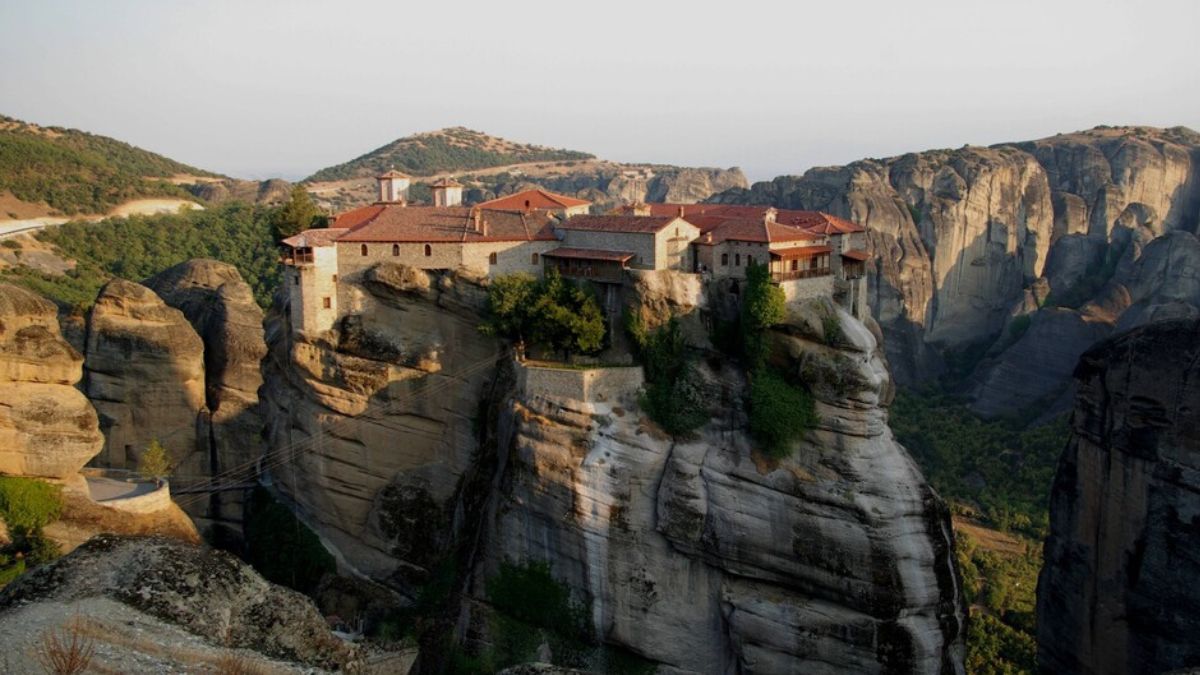In the heart of Greece, Meteora remains suspended in time and air. Renowned for its towering rock formations and monasteries perched precariously atop them, Meteora, a mesmerising UNESCO World Heritage Site is a destination that captivates visitors.
As A UNESCO World Heritage Site
Meteora Monastery, Greece pic.twitter.com/Zm6LDotzJN
— TG ☕️ (@TG22110) July 10, 2022
As “suspended in the air,” the term “Meteora” aptly sums up the essence of the region’s remarkable geological formations. Massive rock pillars that rise to a height of 600 metres were created millions of years ago by a mix of weathering and tectonic processes. The unique topography of the region has made Meteora a natural fortress, providing seclusion and a sense of isolation that has both protected and isolated the monastic communities throughout history.
From the eleventh century onward, monks settled on these “columns of the sky” amid an area of nearly impassable sandstone peaks. At the height of the eremetic ideal’s tremendous resurgence in the 15th century, twenty-four of these monasteries were constructed in spite of extraordinary obstacles. Their frescoes from the sixteenth century represent a pivotal point in the evolution of post-Byzantine painting.
Meteora’s history dates back to the 11th century when the first hermits sought refuge in the caves and fissures of the rocks. Over time, these hermits were joined by monks who, in their quest for spiritual solitude, began to construct monasteries on the soaring summits.
Despite the difficulty of accessing these elevated sanctuaries, the monks and nuns of Meteora developed a system of winches, ropes, and ladders to transport supplies and people.
In 1988, Meteora was inscribed as a UNESCO World Heritage Site, recognizing its outstanding cultural and natural significance. Meteora’s inclusion in the list of World Heritage Sites highlights the need for its preservation and protection.
Also read: To Curb Overtourism, Greece To Allow Only 20,000 Visitors Per Day To Ancient Acropolis Of Athens
Cultural Treasures In Meteora
Meteorahttps://t.co/sr6XBx1uuV#meteora #greece #travel #landscape #travelphotography #grecia #VisitGreece #visitmeteora pic.twitter.com/SmoGxKRHsc
— Photos On The Road (@photosontheroad) January 22, 2022
The monasteries of Meteora house a wealth of cultural treasures, including religious artefacts, manuscripts, and artworks that offer a glimpse into the Byzantine era. The interior of each monastery has vibrant frescoes depicting scenes from the Bible and the lives of saints.
The panoramic views from the monasteries provide a breathtaking perspective of the surrounding landscape. This creates a spiritual and aesthetic experience for those fortunate enough to visit. The delicate balance between accessibility and preservation is crucial to maintaining the integrity of this UNESCO World Heritage Site.
There are now only six monasteries that are open to visitors. Each of them, situated on top of steep cliffs, offers breathtaking vistas. Access is difficult because it needs uphill walking on paved routes. However, it is something you will not regret once you arrive at one of them.
You can also take a hiking trek from the Kastraki area. From Kalabaka, you can stay overnight instead of making it a day trip from Athens. Meteora is easily accessible by public transportation (train or bus), organised tours (group or private), and by automobile. Driving yourself to Meteora is simple and allows you to visit other key sites along the way.
So, when are you visiting Meteora, this UNESCO Heritage site?
Cover image credits: Website/UNESCO
For more such snackable content, interesting discoveries and the latest updates on food, travel and experiences in your city, download the Curly Tales App. Download HERE.




